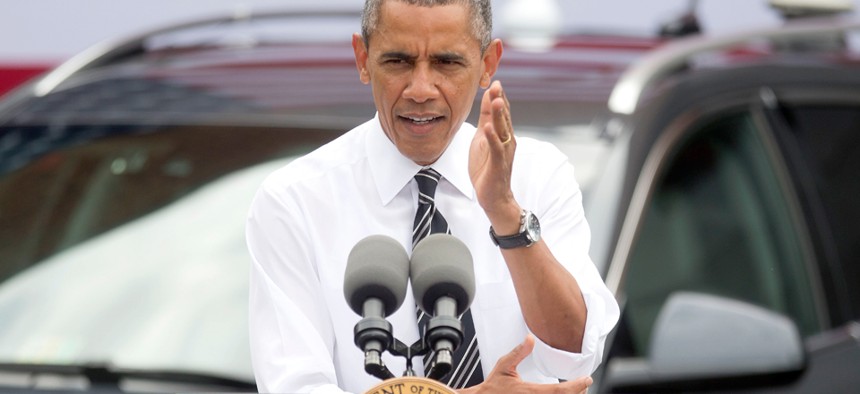Obama's Two Minds on Natural Gas
The White House celebrates the natural-gas boom, so why is it hitting industry with new regulations?
President Obama is doing a two-step when it comes to fossil fuels.
Obama and White House officials clear their throats by praising the oil and gas boom, and even taking a measure of credit for it, before moving on to the specific topic at hand.
There has been a surge in domestic oil and gas production. Gasoline prices keep falling. The natural-gas boom has helped the manufacturing sector. And the combination of oil-production increases and low prices has boosted the U.S.'s foreign policy leverage against petro-states.
But applause for expanded oil and gas drilling is an awkward fit with the president's desire to leave a green legacy and battle climate change.
On Wednesday, the White House announced a wide-ranging strategy to curb emissions of methane, a potent greenhouse gas, from various stages of oil and gas development. The regulations address a paradox with natural gas: It produces far fewer carbon emissions than coal when burned to produce electricity, so it's valuable in the fight against greenhouse gases, but controlling methane further back in the development chain is crucial to ensuring that climate advantage isn't eroded.
The rules still won't allay environmentalists' concerns about air and water pollution from fracking around development sites. At the same time, conservatives and business groups are unhappy with the prospect of more Environmental Protection Agency regulations.
The plan highlights the White House approach to the fracking-enabled domestic-production surge: Take steps to make it cleaner when possible, but keep it going.
Top administration officials have defended fracking against charges that it's causing groundwater pollution. Upcoming Interior Department rules on fracking chemical disclosure, if they hew to a draft version, won't be as strong as advocates have hoped.
"If extracted safely, it's the bridge fuel that can power our economy with less of the carbon pollution that causes climate change," Obama said at last year's State of the Union address.
One former White House official said a middle ground is possible.
"I think both of those important priorities need to be balanced," said Jason Bordoff, who was Obama's senior director for energy and climate change on the National Security Council. "There are economic and security benefits to increasing U.S. oil and gas production, reducing our dependence on imports, and creating more economic activity at home.
"At the same time it is critical, if we are going to move forward with increasing domestic energy production, that we do it safely and responsibly, we have the right rules and regulations in place to deal with many environmental risks and concerns that come along with energy production, conventional or shale," added Bordoff, who now directs the Center on Global Energy Policy at Columbia University.
So while it targets natural gas, the methane plan can be viewed as part of an effort to prevent the oil and gas boom from colliding with a muscular second-term effort to fight climate change.
The goal of the methane plan is to curb oil-and-gas sector emissions by 45 percent by 2025. First-time EPA national emissions standards that are slated for completion in 2016 are at the heart of the plan.
While the methane plan generated praise from several green groups, environmentalists wanted them to go further too. They're not happy that the planned EPA standards, the central pillar of the strategy, apply only to new oil and gas production sites and certain natural-gas infrastructure.
But the EPA rules avoid binding requirements for existing sources, and they're instead addressed through voluntary measures.
Environmental Defense Fund President Fred Krupp called the announcement of regulations a "landmark" moment and said the White House "has set the right goal and launched solid steps to get started.
"However," he added, "we will need a clearer road map and more decisive action to ensure the administration tackles the most important part of the problem—emissions from existing wells, pipelines, and facilities. Otherwise, the goal will not be reached."
NEXT STORY: One Way to Tackle Job Interview Jitters




